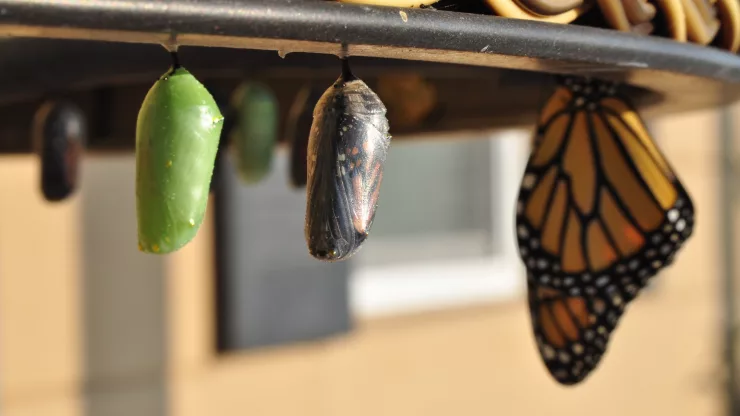Have you ever felt stuck in your personal or professional growth, believing that your abilities are fixed and there’s no room for improvement?
This is a common misconception that’s detrimental to our development and success.
Fortunately, cultivating a growth mindset can help us break free from limiting beliefs and achieve our goals.
In this article, we’ll explore what a growth mindset is, its importance, theories behind its development, and techniques to help us develop a growth mindset for guaranteed success.
Jump to Section
Understanding Growth Mindset and Its Importance
A growth mindset is the belief that our intelligence, abilities, and talents can be developed through dedication, hard work, and continuous learning. This belief empowers us to embrace challenges, persevere through obstacles, and learn from failures.
In contrast, a fixed mindset is the belief that our abilities are innate and cannot be changed, leading to a fear of failure, avoidance of challenges, and a lack of effort.
Having a growth mindset is essential for personal and professional growth as it enables us to:
- Embrace challenges and view them as opportunities for growth
- Learn from mistakes and failures, rather than giving up
- Cultivate a positive attitude towards learning and development
- Emphasize effort over natural ability
- Encourage continuous learning and improvement
- Surround ourselves with growth mindset individuals
- Incorporate mindfulness practices to develop self-awareness
Theories of Developing Growth Mindset
Carol Dweck’s Mindset Theory
Carol Dweck, a Stanford University psychologist, is considered the pioneer of growth mindset research. Her theory suggests that our mindset is not fixed but rather a malleable trait influenced by our beliefs, experiences, and environment.
According to her theory, individuals with a fixed mindset believe their abilities are innate and cannot be changed, leading to a fear of failure and a lack of effort.
In contrast, individuals with a growth mindset believe their abilities can be developed through hard work, learning, and perseverance, leading to a love of challenges and a desire for continuous growth.
Dweck’s research showed that individuals with a growth mindset are more likely to achieve their goals, take on challenges, and persist through obstacles. Moreover, individuals with a growth mindset are less likely to experience anxiety and stress when faced with challenges, as they view them as opportunities for growth rather than threats to their abilities.
Other Theories that Support Growth Mindset Development
Other theories support the development of a growth mindset, including self-determination theory and social cognitive theory.
Self-determination theory suggests that individuals who have autonomy, competence, and relatedness in their lives are more likely to have a growth mindset and achieve their goals.
Social cognitive theory suggests that individuals learn from observing others and modeling their behavior, making it essential to surround ourselves with growth mindset individuals who inspire us to develop a growth mindset.
Techniques to Develop Growth Mindset
Developing a growth mindset is not an overnight process but rather a journey of self-discovery and continuous learning. Here are some techniques to help us develop a growth mindset:
Practice Self-Awareness
Self-awareness is the ability to recognize our thoughts, emotions, and behaviors and how they impact our actions and decisions.
Developing self-awareness can help us identify limiting beliefs, negative self-talk, and other barriers to our growth and success.
Here are some ways to practice self-awareness:
- Journaling: Writing down our thoughts and emotions can help us process them and gain clarity about our beliefs and behaviors.
- Mindfulness: Practicing mindfulness, such as meditation or deep breathing, can help us bring awareness to our thoughts and emotions and develop a non-judgmental attitude towards them.
- Seeking feedback: Asking others for feedback on our strengths and weaknesses can help us identify areas for improvement and develop a growth mindset.
Embrace Challenges
Challenges are opportunities for growth and learning. Embracing challenges can help us develop resilience, grit, and a growth mindset.
Here are some ways to embrace challenges:
- Set challenging goals: Setting achievable but challenging goals can help us push our limits and develop a growth mindset.
- Take risks: Trying new things and taking calculated risks can help us overcome fear of failure and develop a growth mindset.
- Persist through obstacles: Persevering through obstacles and setbacks can help us develop resilience and a growth mindset.
Learn from Mistakes
Mistakes are opportunities for learning and growth. Learning from mistakes can help us develop a growth mindset and avoid repeating the same mistakes.
Here are some ways to learn from mistakes:
- Analyze mistakes: Reflecting on our mistakes and analyzing what went wrong can help us gain insights and develop a growth mindset.
- Take responsibility: Taking responsibility for our mistakes can help us learn from them and develop a growth mindset.
- Develop a growth mindset towards failure: Seeing failures as opportunities for growth rather than threats to our abilities can help us develop a growth mindset.
Cultivate a Positive Attitude
Having a positive attitude towards learning and development can help us develop a growth mindset. Here are some ways to cultivate a positive attitude:
- Focus on progress, not perfection: Celebrating small wins and focusing on progress rather than perfection can help us develop a positive attitude towards learning and development.
- Reframe negative self-talk: Reframing negative self-talk into positive affirmations can help us develop a positive attitude towards learning and development.
- Embrace change: Embracing change and viewing it as an opportunity for growth can help us develop a positive attitude towards learning and development.
Utilize the Power of “Yet”
Adding the word “yet” to our vocabulary can shift our mindset from fixed to growth. Here are some ways to utilize the power of “yet”:
- Reframe negative beliefs: Reframing negative beliefs into positive statements that include the word “yet” can help us shift our mindset from fixed to growth.
- Embrace the learning process: Recognizing that we may not have mastered a skill or concept “yet” can help us embrace the learning process and develop a growth mindset.
- Encourage others: Encouraging others to use the word “yet” can help them develop a growth mindset and overcome limiting beliefs.
Emphasize Effort Over Natural Ability
Emphasizing effort over natural ability can help us develop a growth mindset and avoid the trap of limiting beliefs. Here are some ways to emphasize effort over natural ability:
- Praise effort, not talent: Praising effort rather than talent can help us develop a growth mindset and avoid the trap of limiting beliefs.
- View mistakes as opportunities for growth: Viewing mistakes as opportunities for growth rather than threats to our abilities can help us develop a growth mindset and avoid the trap of limiting beliefs.
- Embrace challenges: Embracing challenges and viewing them as opportunities for growth can help us develop a growth mindset and avoid the trap of limiting beliefs.
Encourage Continuous Learning
Continuous learning is essential for personal and professional growth. Encouraging continuous learning can help us develop a growth mindset and achieve our goals.
Here are some ways to encourage continuous learning:
- Read books: Reading books on personal and professional growth can help us develop a growth mindset and learn new skills and concepts.
- Attend courses: Attending courses and workshops on personal and professional growth can help us develop a growth mindset and learn new skills and concepts.
- Seek mentorship: Seeking mentorship from growth mindset individuals can help us develop a growth mindset and learn from their experiences.
Surround Yourself with Growth Mindset Individuals
Surrounding ourselves with growth mindset individuals can help us develop a growth mindset and learn from their experiences. Here are some ways to surround ourselves with growth mindset individuals:
- Join communities: Participate in groups or communities that foster a growth mindset, be it online forums, local clubs, or professional networks. This can expose us to new perspectives, ideas, and constructive criticism.
- Find mentors: Mentors can guide us with their experiences and provide feedback, helping us navigate challenges and encouraging us to embrace opportunities for growth. Look for mentors who embody a growth mindset and can inspire and motivate you.
- Engage in growth mindset conversations: Regularly engage in conversations that focus on learning, growth, and potential. This includes discussing personal experiences, new ideas, and future goals, and providing and receiving feedback in a constructive manner.
Practice Active Listening
Active listening is a critical skill for developing a growth mindset. When we actively listen, we fully concentrate, understand, respond, and then remember what is being said.
This practice can enhance our learning ability and help us develop a growth mindset. Here are some ways to practice active listening:
- Focus on the speaker: Avoid distractions and focus completely on the speaker. Understand their message, observe their body language, and respond appropriately.
- Ask open-ended questions: This can promote further discussion and lead to deeper understanding. It also demonstrates respect for the speaker’s thoughts and feelings.
- Give feedback: After understanding the speaker’s viewpoint, provide thoughtful and respectful feedback. This practice not only improves communication but also promotes learning and growth.
Adopt a Growth Mindset Language
The language we use can profoundly influence our mindset. Adopting a growth mindset language can help us see challenges as opportunities, effort as the path to mastery, and failure as a chance to learn.
Here are some ways to adopt a growth mindset language:
- Use positive affirmations: Affirmations are powerful tools that can influence our mindset. Start your day with positive affirmations like, “I can learn anything I want to,” “I embrace challenges,” or “Effort leads to my success.”
- Replace “failing” with “learning”: When we make a mistake, instead of saying, “I failed,” we can say, “I learned.” This simple switch can make a big difference in how we perceive our performance.
- Celebrate effort and strategies: Use language that emphasizes effort, strategies, and process, not just the outcome. For instance, instead of saying, “You’re so smart,” we can say, “You must have worked really hard on this.”
Remember, developing a growth mindset is a journey, not a destination. It requires consistent practice, effort, and a willingness to embrace challenges and learn from them.
With these techniques, you can cultivate a growth mindset and unlock your potential for continuous learning and development.
Growth Mindset FAQ
What is a Growth Mindset?
A growth mindset is the belief that our abilities and intelligence can be developed through dedication, hard work, and the right kind of training. This concept was introduced by psychologist Carol Dweck.
How can I Develop a Growth Mindset?
There are various techniques to develop a growth mindset, including practicing self-awareness, embracing challenges, learning from mistakes, cultivating a positive attitude, utilizing the power of “yet”, emphasizing effort over natural ability, encouraging continuous learning, and surrounding yourself with growth-minded individuals.
How can a Growth Mindset help me in my Career?
A growth mindset can help you thrive in your career. It can make you more resilient in the face of challenges, more willing to take calculated risks, and more capable of learning from your mistakes.
It encourages continuous learning and development, which are key to advancing in your career.
How does a Growth Mindset differ from a Fixed Mindset?
While a growth mindset believes that abilities and intelligence can be developed through effort and persistence, a fixed mindset believes that these qualities are innate or fixed and cannot change. The key difference lies in the perception of potential for change and growth.
How can I encourage a Growth Mindset in my Child?
You can encourage a growth mindset in your child by praising their effort rather than their innate abilities, teaching them that it’s okay to make mistakes as they’re opportunities to learn, setting realistic but challenging goals for them, and modeling a growth mindset through your own actions and attitudes.
Is it Possible to Change from a Fixed Mindset to a Growth Mindset?
Yes, it is absolutely possible to change from a fixed mindset to a growth mindset. This requires awareness of your current mindset, understanding the benefits of a growth mindset, and taking concrete steps to cultivate a growth mindset such as embracing challenges, persisting in the face of setbacks, and viewing effort as a path to mastery.
Can a Growth Mindset Improve my Personal Relationships?
Yes, a growth mindset can improve your personal relationships.
It can make you more open to feedback, more willing to acknowledge and address your flaws, and more capable of seeing challenges as opportunities for growth and development in your relationships.
It can also encourage empathy, as you recognize that everyone is capable of growth and change.

With a deep passion for personal development, Ben has dedicated his career to inspiring and guiding others on their journey towards self-improvement.
His love for learning and sharing knowledge about personal growth strategies, mindfulness, and goal-setting principles has led him to create My Virtual Life Coach.
Contact Ben at [email protected] for assistance.




